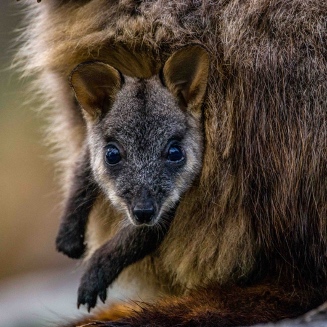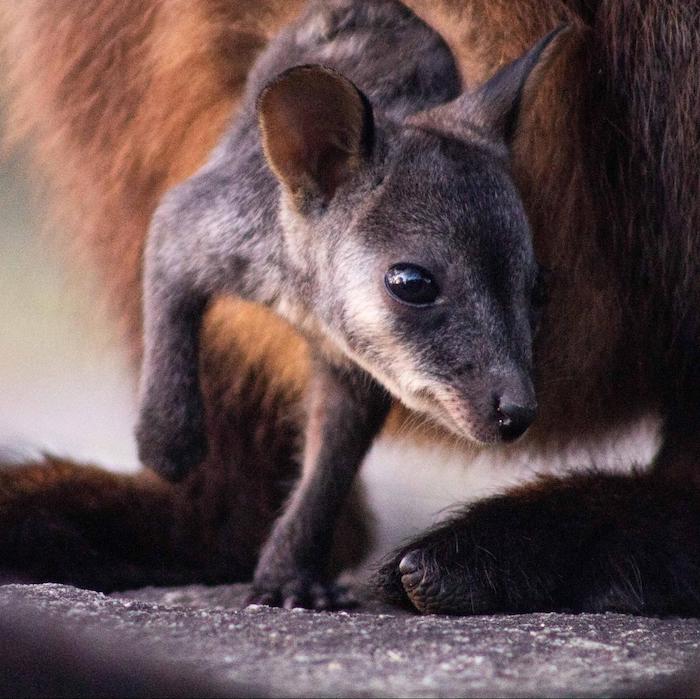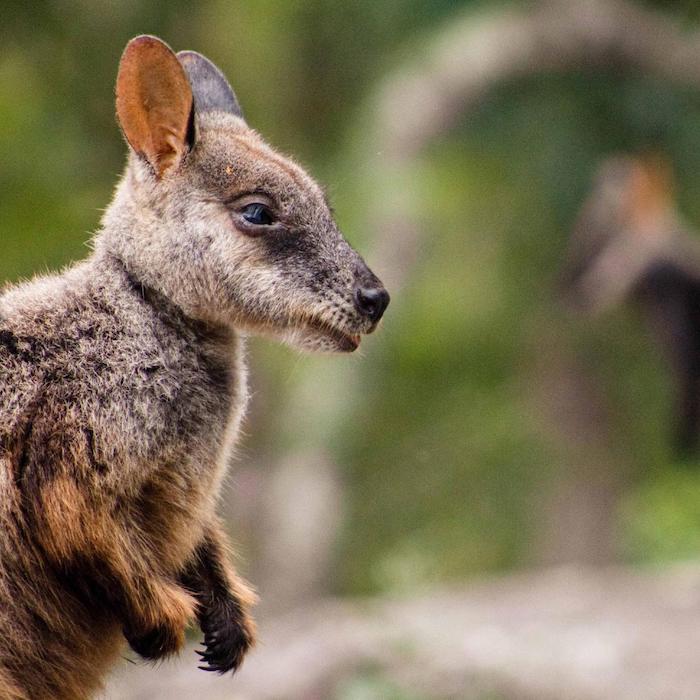Research
Research into Brush-tailed Rock-wallabies
The Friends of the Brush-tailed Rock-wallaby have been working hard with NPWS to understand Brush-tailed Rock-wallaby behaviour and threats, to better our understanding of this unique species and promote more targeted and effective management of the colonies.
What do we need to know about Brush-tailed Rock-wallabies?
- Being able to identify individual Rock-wallabies provides information on survival rate, colony dynamics and movements, giving us critical data to inform rock-wallaby research state-wide.
- If we can better understand the Rock-wallabies making up a colony, NPWS experts can understand how and when to intervene in the colony, including when it may be necessary to introduce individuals to boost numbers.
- If we can understand whether young animals disappear due to predation or because they disperse to find new territory, we can better target our intervention on predator control, etc
How are we involved in rock-wallaby research?
The Friends of the Brush-tailed Rock-wallaby support various methods of monitoring involving new research technologies to research fragile Rock-wallaby colonies. Hover over each method to learn more.
Identification
Tracking
Surveying
Research into Brush-tailed Rock-wallabies helps us to learn more about their habitat, diet, behaviour, and the types of predators they face. We need to understand these animals and the way they live to better protect them and ensure their long-term survival.
The Brush-tailed Rock-wallaby ranges from Queensland to Victoria, roughly following the line of the Great Divide. The southernmost population in NSW is in the Shoalhaven, while the Warrumbungle Ranges are home to the westernmost population.
The NSW National Parks and Wildlife Service (NPWS) began the Shoalhaven Brush-tailed Rock-wallaby Protection Program in 1995. The species was listed as vulnerable at the time and known to be in decline throughout much of its range.
A survey of Rock-wallaby distribution in parts of southern New South Wales in 1995 identified the Kangaroo Valley area as an important stronghold for Rock-wallabies in southern NSW. It was recommended that a 1080 fox baiting program be instigated to reduce predation pressure on the Rock-wallabies and to aid Rock-wallaby survival and population growth.
This program was commenced in the Kangaroo Valley area in 1995. At this time, it was estimated that there were between 30 to 60 Rock-wallabies remaining in the Shoalhaven.
In the Kangaroo Valley area, Brush-tailed Rock-wallaby colonies are located primarily on private property. This provided the opportunity for the community to become involved in Rock-wallaby management in the Shoalhaven. NPWS encouraged landholders to conduct 1080 fox baiting on their lands with NPWS supplying equipment, training, and supervision. Where landholders were supportive but not interested in conducting their own baiting, NPWS sought permission to conduct baiting for them. NPWS also began fox baiting on NPWS land in the area as well as Crown Land and Sydney Catchment Authority land.
In 1998 the Rock-wallaby program received joint funding from Environment Australia with a similar Brush-tailed Rock-wallaby program in the Hunter Valley region. The funding continued through to 2001. A major aim of this joint program was to determine the effect of 1080 fox control on both the fox and Rock-wallaby populations. Consistent monitoring of the fox and Rock-wallaby populations in the baited area (Kangaroo Valley) and in an adjacent unbaited area (Illaroo) commenced in June 1998.
The results of the surveying efforts indicate that between 1998 and 2001, the abundance of Rock-wallabies in the baited colonies declined at a significantly slower rate and fox numbers were significantly lower compared to those in the unbaited area. It is possible that the reduced fox densities in the baited area resulted in the slower decline of Rock-wallaby numbers in this area. Nevertheless, Rock-wallaby numbers were considered necessary to ensure their survival. As a result, the baiting strategy was reviewed in 2001 with the aim of improving the effectiveness of fox control. Following the review, several private properties (where fox baiting was expected to dramatically improve colony protection) were targeted for inclusion in the baiting program. Fox baiting was also extended to the Illaroo area (previously unbaited site) in April 2002.
In 2001, the NSW Fox Threat Abatement Plan (Fox TAP) was introduced to address the impact of predation by the Red Fox on threatened species. This plan identified Brush-tailed Rock-wallabies as one of a suite of threatened species most likely to be impacted by fox predation and thus a high priority for the assistance of fox control. The plan also identified the Shoalhaven area as one of a dozen priority sites in NSW.
The first translocations of Rock-wallabies in NSW was undertaken in 2007, with the introduction of 3 individuals into a struggling local colony. It was run as a trial to see if released individuals would integrate into the colony. Learnings from this release led to several additional releases of Rock-wallabies into local colonies to bolster numbers to a level where they could escape the extinction vortex (where the few young produced each year are too easily lost to chance events that the colony is not able to recover even in the face of extensive predator control).
In 2016 the Saving Our Species Program began in NSW – its main objective being to increase the number of threatened species that are secure in the wild in New South Wales for 100 years and control the key threats facing our threatened plants and animals. The ongoing protection of the Shoalhaven Rock-wallabies were incorporated as a priority site into this program and protection works continue today,
In 2020 with the assistance of the Friends for National Parks and Wildlife Conservation Grants Program, a radio-tracking research project was implemented by the Friends of the Brush-tailed Rock-wallaby (BTRW) in close collaboration with the NSW Government Saving our Species (SoS) Kangaroo Valley BTRW Recovery Project Coordinators. Three self-detaching GPS collars, a radio- tracking antenna/receiver and a Pinpoint Commander were purchased with the grant which also covered part of the labour costs for trapping and the initial 6 months of weekly radio-tracking of two young male Rock-wallabies at the River Colony by an experienced contractor. Whilst many male Rock-wallabies successfully reared at this colony over the last decade have disappeared around the time of reaching sexual maturity, radio-collared Magic and Ruben remain anchored to the colony. The contractor was able to get close enough to these Rock-wallabies using the radio-tracking equipment to download GPS ‘fixes’ stored on the collars. From preliminary mapping of this GPS data over 50% of the 5 programmed ‘fixes’ per day per collar were receiving enough satellite coverage to accurately map the broad movements of the young Rock-wallabies within and temporarily away from the colony. While two other younger sub adults disappeared since September 2020, Magic and Ruben and a third younger sub adult have remained in the vicinity of the colony.
As this is the first time such radio-tracking technology had been applied to Brush-tailed Rock-wallabies there were many uncertainties, one being the GPS collars could have detached prematurely. This did not occur and the two young males reached sexual maturity whilst being radio-tracked without dispersal or predation. Although Magic and Ruben have explored well beyond the colony in search of a neighbouring colony (as per their instincts), they remain anchored in or adjacent to the core colony. unlike many young males reaching sexual maturity in the past. The young GPS-collared males appear to have made bonds with some younger females and have remained at the colony, as the current alpha males age.
A follow up session of the radio-tracking research project was undertaken in 2023. During this time, approximately 19 adult brush-tailed rock-wallabies (BTRW) were recorded via camera monitoring at the River colony, whilst 3 males were captured and collared with satellite tracking collars (Tamboti, Wirrin and Yalonga).
Throughout this monitoring period the 3 collared males remained in the vicinity of the known colony, however Wirrin who was the dominant male died of natural causes. Wirrin dominated the area directly around the central property, near the core colony. Tamboti’s range was further afield at the start of the year and then moved in the later months to the central property (roughly coinciding with Wirrin’s death), whilst Yalonga ventured the most out of the core colony to the North.
The data gained from the radio-tracking research project may be further analysed in order to decipher general activity timing, such as hours and locations of foraging activity and also identify areas that the BTRW rest in during the day. This may help inform fire and land management practices to enhance and protect foraging and resting areas. Further, the location data could provide insight into better camera placement for detection and monitoring.
If the project were to continue into the future, it would be beneficial to collar a large subset of mixed age BTRW in order to achieve a better understanding of cause of death or movement. The advantage of the project and the collaring is highlighted by the fact that Yalonga was not observed or seen on the monitoring camera for 4 months, therefore we would not be aware that he was around (on the eastern fringe of the colony) if it wasn’t for the collar.




